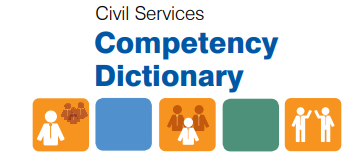
Background
In recent years, there is a growing demand for a more accountable system in public administration. This has led to the development of a competency based human resource in governance for civil servants. The concept of competency has been applied extensively both to the individual civil servant and to the planning and implementation of policies and programmes of the government. Competencies have been defined in many ways. However, a practical and easy to understand definition of competencies has been provided by Boyatzis (of Hay Group, 1982). It states that competencies are those underlying characteristics of an employee – motive, trait, skill, aspects of one’s social image, social role or a body of knowledge, which can result in effective and/or superior performance in a job or role.
The definition of competencies has been explained beautifully by L.M. Spencer and S.M. Spencer through Iceberg model. In this model, they talk about five types of competencies’ characteristics of an individual in different circumstances. However, as seen in the ice-berg (which has just one-ninth of its volume above water and the rest remains beneath the surface in the sea), some of the competencies components of an individual are visible like knowledge and skills but other behavioural components like attitude, traits, thinking styles, self-image, organizational fit etc are hidden or beneath the surface.
In the traditional method of governance, most of the Ministries, Departments and Organisations (MDO) looked simply at the visible components of their civil servants- knowledge and skills. However, in more complex jobs the aspects of competencies which lie below the surface like attitude, traits, thinking styles etc directly influence the usage of knowledge and skills; therefore, are more vital and indispensable to complete a job effectively.
For MDOs, improving and scaling up of the visible competencies like knowledge and skills can be easily done through training and skill building exercises. On the other hand, the behavioural competencies are rather difficult to assess and develop. It takes more time and effort intensive exercises which include intensive training, coaching and mentoring, developmental experiences etc. Therefore, capacity building of civil servants needs to be changed and more emphasis shall be put on improving the masked behavioural aspects of Civil servants. For that a comprehensive capacity building programme for every civil servant primarily focusing on accountability, transparency, equity and inclusiveness, participatory, consensus orientation, rule of law, effectiveness and efficiency is essential.
In lieu of that, the Department of Personnel and Training aims to strengthen the Human Resource Management of Civil Service with the Mission Karamayogi. The mission focuses on role based capacities of civil servants and strengthening their enabling environment in view of a more effective, efficient, transparent and accountable Public Administration at National and State level. It envisages achieving the Government of India objective of inclusion through an enhanced delivery of services to the marginalised and vulnerable. This mission is supporting the Government of India (GoI) in the shift towards Competency-based Human Resource Management (HRM) for the Indian Civil Services.
About the proposed Competency Based Training Course:
The new competency based governance model provides an opportunity for Central Training Institutes like Indian Institute of Public Administration (IIPA) to design Competency Based Training (CBT) for the Indian Civil Service. Taking the task, IIPA has developed a Competency Based Training Module focusing on the application of competencies with HRM practices. The CBT contains 30 competencies which have been categorized under five broad areas namely Ethos, Ethics, Equity, Efficiency and Productivity. Each competency has a definition and its proficiency levels. Further, each proficiency level has behavioural indicators which are objective, observable and measurable.
The below five broad categories contains 30 competencies. Each competency has a definition and its proficiency levels. Further, each proficiency level is required for various positions MDOs.
The prime objective of the CBTs is to stimulate the inner strength and capabilities and also to improve the functional competencies of individual officers.
Ethos
Ethics
Equity
Efficiency
Productivity
Probable outcome of the competency based CBTs
There are certain clear benefits of the Competency Based Training for the MDOs:
| Training | Faculty |
| People First | Dr. Neetu Jain |
| Strategic Thinking | Dr P K Taneja |
| Organisational Awareness | Dr Suresh Misra |
| Commitment to the Organisation | Dr Mamta Pathania |
| Leading Others | Dr Sachin Chouwdhry |
| Integrity | Dr K K Pandey |
| Self Confidence | Dr. Nupur Tiwari |
| Attention to Detail | Dr G Mohapatra |
| Taking Accountability | Dr Charru Malhotra |
| Consultation and Consensus Building | Dr Surabhi Pandey |
| Decision Making | Dr Saket Bihari |
| Empathy | Dr V K Sharma |
| Delegation | Dr V N Alok |
| Results Orientation | Dr Roma Mitra |
| Conceptual Thinking | Dr Pawan Taneja |
| Initiative and Drive | Dr Shyamli Singh |
| Seeking Information | Dr Saket Bihari |
| Planning and Coordination | Dr K K Pandey |
| Desire for Knowledge | Dr Charru Malhotra |
| Innovative Thinking | Dr Kusum Lata |
| Problem Solving | Dr V N Alok |
| Developing Others | Dr Saket Bihari |
| Self-Awareness and Self-Control | Dr Manan Dwivedi |
| Communication Skills | Dr Ashok Vishandas |
| Team-Working | Dr Neetu Jain |
| Office Management (Parichay) | Dr Ashok Vishandas |
| Human Resourse Management (Disciplinary Work) | Dr Amit Singh |
| Information Management (Court Matters) | Dr Sapna Chadah |
| Compliance Management (Audit) | Dr Roma Mitra |
| Parliamentry Matters (Questions & Committee) | Dr Sachin Chouwdhry |
| Social Media | Dr Charru Malhotra |